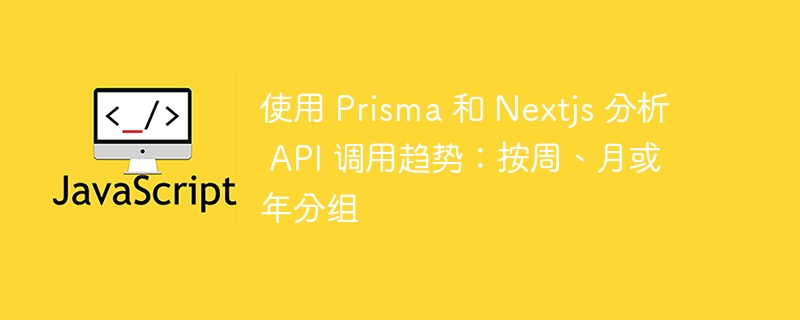使用 Prisma 和 Nextjs 分析 API 调用趋势:按周、月或年分组
时间:2025-01-27 14:21:52 397浏览 收藏
从现在开始,我们要努力学习啦!今天我给大家带来《使用 Prisma 和 Nextjs 分析 API 调用趋势:按周、月或年分组》,感兴趣的朋友请继续看下去吧!下文中的内容我们主要会涉及到等等知识点,如果在阅读本文过程中有遇到不清楚的地方,欢迎留言呀!我们一起讨论,一起学习!

本文将阐述如何利用 Prisma 根据日期(日、月或年)对数据进行分组,并结合 Next.js 和 MongoDB,构建一个 API 调用趋势分析工具。通过这个示例,我们将学习如何查询数据,追踪 API 调用指标,例如一段时间内的成功率和调用频率。
简化 API 调用数据模型
为了有效分析 API 调用趋势,特别是按周、月或年分组,我们需要一个精简的数据模型。以下 Prisma 架构足以满足需求:
<code>model apicall {
id string @id @default(auto()) @map("_id") @db.objectid
timestamp datetime @default(now())
status apicallstatus // success 或 failure 枚举
}
enum apicallstatus {
success
failure
}</code>
该模型记录每个 API 调用的时间戳和状态,为趋势分析提供必要信息。
查询 API 调用趋势
以下代码展示了 Next.js API 端点的实现,该端点通过按不同时间段分组数据,提供 API 调用趋势的洞察。此端点有助于监控 API 使用模式,并有效识别潜在的系统问题:
{
"apiCallTrends": [
{
"_id": "2025-01", // 按月份分组 (2025年1月)
"success": 120,
"failure": 15,
"total": 135
},
{
"_id": "2025-02", // 按月份分组 (2025年2月)
"success": 110,
"failure": 10,
"total": 120
},
{
"_id": "2025-03", // 按月份分组 (2025年3月)
"success": 130,
"failure": 20,
"total": 150
}
// ...更多按月分组的结果
]
}
主要亮点
- 动态日期分组: 根据用户请求参数,灵活地按年、月或日对 API 调用进行分组。
- 趋势分析: 计算每个时间段的成功、失败次数以及总调用次数。
- 错误处理: 提供友好的错误信息,提升 API 使用体验。
- 效率: 利用 MongoDB 的聚合管道,优化查询性能,减少服务器负载。
结论
本方案展示了如何使用 Prisma ORM 从 MongoDB 中查询并按不同时间范围对时间戳进行分组。 希望本文对您有所帮助!
以上就是《使用 Prisma 和 Nextjs 分析 API 调用趋势:按周、月或年分组》的详细内容,更多关于的资料请关注golang学习网公众号!
相关阅读
更多>
-
502 收藏
-
501 收藏
-
501 收藏
-
501 收藏
-
501 收藏
最新阅读
更多>
-
368 收藏
-
234 收藏
-
487 收藏
-
392 收藏
-
362 收藏
-
347 收藏
-
188 收藏
-
408 收藏
-
297 收藏
-
105 收藏
-
166 收藏
-
357 收藏
课程推荐
更多>
-

- 前端进阶之JavaScript设计模式
- 设计模式是开发人员在软件开发过程中面临一般问题时的解决方案,代表了最佳的实践。本课程的主打内容包括JS常见设计模式以及具体应用场景,打造一站式知识长龙服务,适合有JS基础的同学学习。
- 立即学习 543次学习
-

- GO语言核心编程课程
- 本课程采用真实案例,全面具体可落地,从理论到实践,一步一步将GO核心编程技术、编程思想、底层实现融会贯通,使学习者贴近时代脉搏,做IT互联网时代的弄潮儿。
- 立即学习 516次学习
-

- 简单聊聊mysql8与网络通信
- 如有问题加微信:Le-studyg;在课程中,我们将首先介绍MySQL8的新特性,包括性能优化、安全增强、新数据类型等,帮助学生快速熟悉MySQL8的最新功能。接着,我们将深入解析MySQL的网络通信机制,包括协议、连接管理、数据传输等,让
- 立即学习 500次学习
-

- JavaScript正则表达式基础与实战
- 在任何一门编程语言中,正则表达式,都是一项重要的知识,它提供了高效的字符串匹配与捕获机制,可以极大的简化程序设计。
- 立即学习 487次学习
-

- 从零制作响应式网站—Grid布局
- 本系列教程将展示从零制作一个假想的网络科技公司官网,分为导航,轮播,关于我们,成功案例,服务流程,团队介绍,数据部分,公司动态,底部信息等内容区块。网站整体采用CSSGrid布局,支持响应式,有流畅过渡和展现动画。
- 立即学习 485次学习
